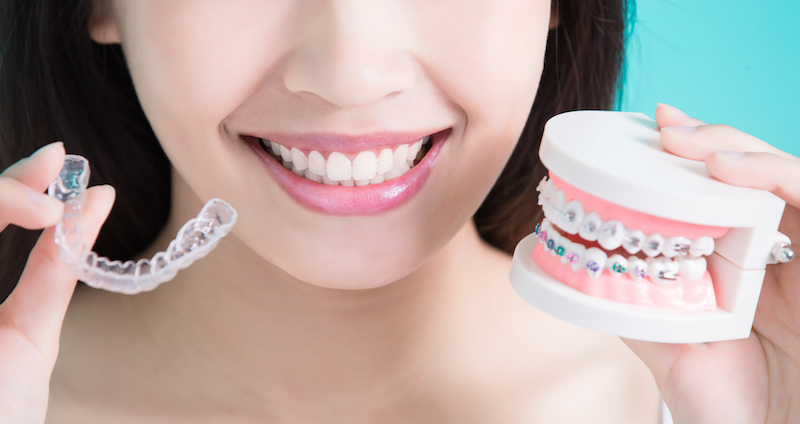Today’s orthodontic patients have choices that patients of 20 years ago didn’t have, and one of those choices is braces vs clear aligners. Back then if you needed braces, there was only one choice. Now the multiple options mean patients need to work through the pros and cons with their orthodontist to decide which is the best method for them. Clear aligners and braces both have their pros and cons which we will examine here.
Visible Treatment Vs Concealed
Clean aligners, or commonly called Invisalign, have the obvious benefit of being less noticeable than standard braces. Aligners can only be seen close-up and are often undetectable in photos.
Non-Removable Vs Removable
Some people will choose aligners for the freedom of being able to take them out when they want. They like to not worry about eating foods that may damage their braces. While wearing braces, patients usually need to modify their diet a little or do some preparation to ensure they don’t eat anything that’s too hard, crunchy or chewy.
Other people don’t want the hassle of taking the trays in and out whenever they want something to eat. The trays are worn for close to 22-23 hours every day to work efficiently. As soon as they have finished eating or brushing, the trays should go back in their mouth. Some patients will start out being diligent but as the months roll on, they become less concerned, their treatment stalls and the timeframe extends.
Good Vs Poor Oral Hygiene
For some patients, oral hygiene isn’t one of their priorities. They brush their teeth when they remember and rarely give the job the attention it deserves. Before undertaking braces, they need to recognize that they need to improve the quality and quantity of their teeth brushing. If not, they could finish their treatment to find they have white spots on their teeth. The spots are either permanent or need cosmetic treatment to remove or make them less visible.
While it is vital for all orthodontic patients to adopt good teeth-brushing habits, clear aligners will be less forgiving. Invisalign patients are less likely to develop the calcium spots or severe gum problems that braces patients can develop with poor habits. Invisalign patients are at risk of tooth decay, however.
Invisalign covers the teeth, so the bacteria and plaque can become trapped between the tray and the teeth. The teeth don’t benefit from saliva ‘washing’ the teeth. Anyone considering orthodontic treatment should commit to good oral hygiene for the entire procedure to gain the best outcome.
Short or Long Treatment Time
If you aim to complete treatment as soon as possible, braces can move teeth into the desired position faster than Invisalign. Invisalign trays are swapped out every two weeks, and the changes between each one can only be minor. Braces can close large gaps and align teeth more efficiently.
Complex Vs Simple Cases
Everyone has different teeth. Therefore, every orthodontic treatment is slightly different. Some people have multiple issues that require attention during their treatment while others are simple and straightforward. Invisalign works well for patients with mild to moderate crowding, but for more complicated cases, the biomechanics of braces are needed to rotate and pull teeth into position and correct bites.
Which Option Is Best for You?
Your orthodontist will go through each option and explain why it is suitable or not for you. Once you have all the information, It’s up to you to decide which option suits your lifestyle and level of commitment.
If you would like to know if you are a candidate for braces, find an orthodontist near you today!
Source: https://www.theorthodontists.com.au/blog/braces-vs-clear-aligners

